Reply To:
Name - Reply Comment
Last Updated : 2024-04-20 13:31:00
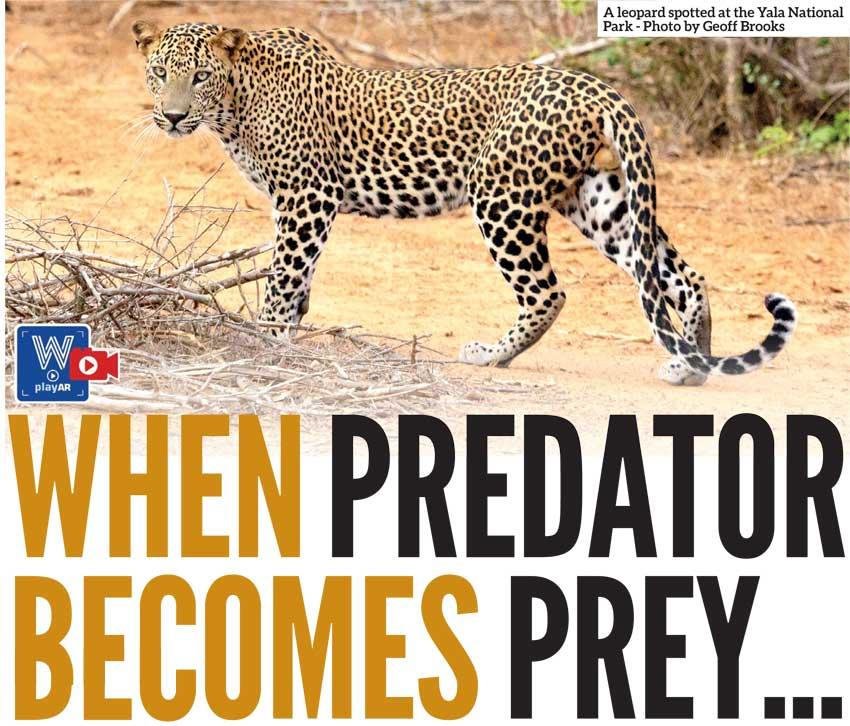

Reporting by Kalani Kumarasinghe, Kamanthi Wickramasinghe, Yoshitha Perera, Sheain Fernandopulle and Piyumi Fonseka
Known for their elusive nature and fierce hunting techniques, leopards have long been one of the most secretive and feared predators known to mankind. In the past week, however, Sri Lanka witnessed a role-reversal where the country’s exotic leopard --the apex predator-- fell prey to ruthless humans.
Within the span of just five days, three Sri Lankan leopards were found caught in wire snares, in which two of these magnificent beasts were killed.
The first death reported was of a rare black leopard which was caught in a snare set at a private estate in the Nallathanni highlands on May 29.

The existence of the Sri Lankan Black Leopard which was believed to be extinct was confirmed by the Department of Wildlife Conversation (DWC) earlier this year after several sightings were recorded on film by the department’s researchers.
The trapped Black Leopard was discovered several kilometres away from where a Black Leopard was initially spotted. Although there have been some reports of Black Leopard sightings in Sri Lanka, DWC officers confirmed there was only one black leopard reportedly living in Hatton.
After a case was filed by the DWC, a suspect was arrested on the charges of setting the trap and subsequently produced in court by relevant authorities.
However, on the morning of May 29, DWC officials confirmed that the Black Leopard succumbed to its injuries.
Hours after its death, another leopard was found ensnared in Yatiyanthota. After a six-hour rescue mission, the leopard was tranquilised, treated and eventually released to the wild.
As images of the rescue efforts began circulating on social media, activists were quick to point out the obvious failures of wildlife officers in allowing large crowds to gather around the frightened and restrained animal.
On June 2, a third leopard, caught by a snare trap, was discovered dead in a private estate in Neluwa, Galle.
DWC Director-General M.G.C. Sooriyabandara said a postmortem examination would be performed by the department while legal action would be taken against those responsible for setting the trap.
Wildlife Health Director at the Department of Wildlife Conservation, Dr. Tharaka Prasad told Daily Mirror the carcass was at least five days old at the time of being discovered and that the leopard’s canines had been found removed after its death.
DWC lapses exposed
The consecutive discoveries of trapped leopards sparked public outrage while environmental conservation organisation Leopocon called for the DWC to address the many loopholes hindering wildlife conservation in Sri Lanka.
Issuing a statement, the organisation said there was no consensus conducted to accurately estimate the leopard population of Sri Lanka while no leopard conservation programme had been launched by the DWC.
“With this incident, it is clear that the number of annual leopard deaths could be far greater than what is reported, with much of these deaths going unreported,” the organisation said.
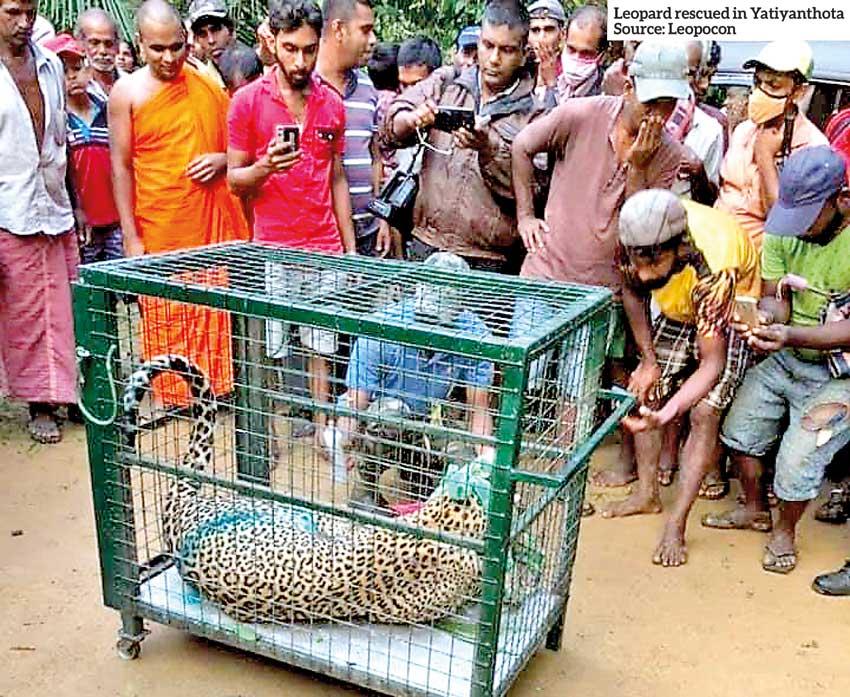
It added that conservationists estimate at least 20 leopard deaths taking place in Sri Lanka annually. Unfortunately, the organisation observed that this was the fourth time a rare Melanistic Leopard or a Black Leopard was killed by snares.
According to a damning 2018 report by the Auditor-General on the performance of the DWC, the department had failed to introduce a suitable procedure for the protection of leopards and their community growth or safety of leopards and the public. 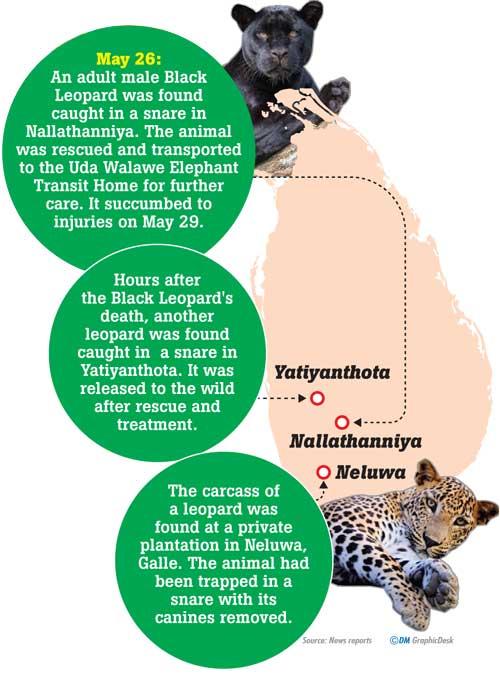
The report credited findings of research organisation ‘The Wilderness and Wildlife Conservation Trust’ which revealed there had been about 750-1000 leopards by the end of the year 2017. They further revealed that 35 leopards had died between 2001 and 2017.
The report noted that Sri Lankan leopards were animal species which occupy territories that were demarcated by themselves.
“When a strange leopard invades an area, that leopard is at a greater risk. Most leopard species can be seen in upcountry areas and their lives are threatened with rapid colonisation of those areas,” the report states. “A statistical data network on leopards of Sri Lanka was not available with the department and due to the destruction of forest resource, the survival of leopards living in sanctuaries had been affected. It was observed that necessary steps had not been taken to carry out a study relating to biodiversity and to act accordingly.”
Further identifying serious lapses within the DWC, the audit concluded that the department had not taken action to retain observation reports on leopards or to hold a census or conduct surveys and research.
Endangered and ensnared
Rukshan Jayawardene, a conservationist who has spent decades studying the Lankan leopard, opines the widespread use of wire snares takes quite a big cost on the wildlife of the country. 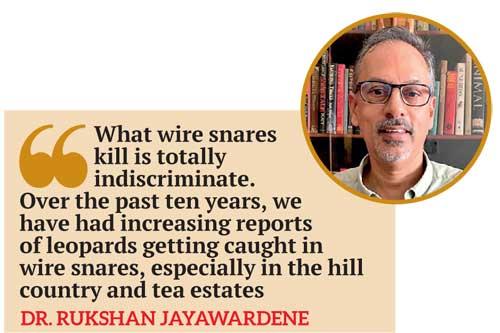
“What wire snares kill is totally indiscriminate. Over the past ten years, we have had increasing reports of leopards getting caught in wire snares, especially in the hill country and tea estates,” he said. “Wire snare use has to be stamped out. It is something that is destroying the natural wealth of this country. Leopards are just one of the species which lose their life but leopards are an important animal; it is very valuable to Sri Lanka’s tourism industry; it is a flagship species and is also an apex predator in this country. It is extremely important for the ecosystem it lives in.”
Daily Mirror spoke to wildlife officer Prabasha Karunathilake based in Nallatanni who said that within the first five months of 2020, six leopards were discovered trapped in snares. Only three of them were released to the forest alive. Unfortunately, the remaining three succumbed to their injuries. 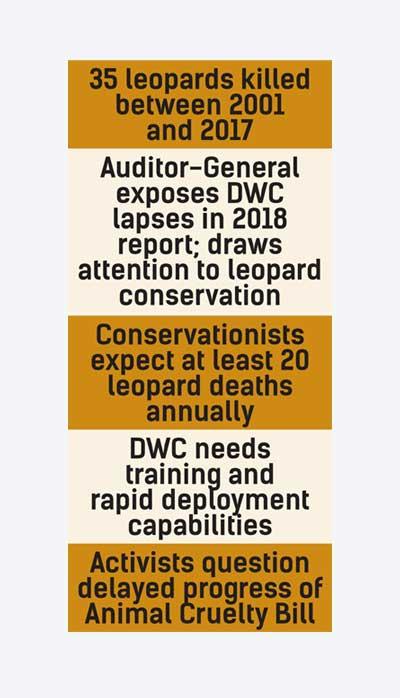
“People in central highlands are not aware of the importance of this animal, given that it’s an endangered species. Nor do they understand the importance of the animal to nature or its role when it comes to maintaining the natural balance. They only see the threat to themselves,” he said.
He said the leopard population was declining due to several threats. “Habitat loss and fragmentation, prey depletion, conflict with humans are the most significant among them, threatening extinction for these rare species. Leopards sometimes stray into the villages, hunting for food, especially dogs. With habitat change, there has been a major threat to these animals. To survive in these areas and to prevent these unfortunate incidents from happening in future, people need to cooperate with the wildlife department officials,” he said.
He said they had been strictly advising people against setting snares for these animals and further mentioned that the officials were keen on educating people about the legal consequences for their actions. “According to the Fauna and Flora Act in Sri Lanka, setting snares for animals is considered a major offence and those who commit such an offence could be remanded for a lengthy period,” he said.
He noted that while Hatton District Judge and Magistrate J. Trotsky ordered a postmortem of the Black Leopard, he was unable to comment on the exact cause of death of the animal. However, he observed that the Black Leopard was not seriously injured during the rescue mission, but after taking the animal to the Uda Walawe treatment facility, the different climatic environment could have possibly had an impact on its death.
Wildlife Department needs reinforcements
The Black Leopard which had suffered severe injuries at the time of rescue was tranquilised and transported to the Uda Walawe elephant transit home for treatment, some 120 kilometres away from Nallatanni.
DWC officials said the rescue team travelled a minimum distance to the location which they assured was the closest facility where the leopard could be treated at. 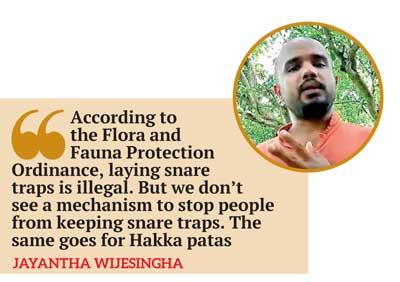
Nevertheless, conservationists have criticised the lack of DWC facilities in central highlands closer to national forest reserves where several animal traps are reported frequently.
“These animals have suffered excruciating, agonising and painful deaths. The Wildlife Department is expected to respond to these situations. But since they’re located in Randenigala, Rantembe and Uda Walawe, their response time is slow. It takes many hours for them to get to these areas in central highlands where many of these unfortunate incidents happen,” Jayawardene said. “The autopsy report is due and we don’t know the exact cause of death of this animal. But one of the reasons that made the survival of this leopard difficult was that once the leopard was caught in the snare, it took the Wildlife Department a fair amount of time -- far longer than it should have -- for them to immobilise the leopard and get it off the snare. When this time is minimised, the survival chances are greater and chance of the animal injuring itself on the snare is minimised.” 
He did not fail to observe the gaping flaws in the country’s wildlife conservation efforts. “The Wildlife Department needs a rapid deploying capability and needs to be located far closer to central highlands or within the central highlands itself. They also need treatment and training facilities that are up to date. We also need foreign expertise to understand what happens to big cats when they are caught in situations like this when their flight or fight response cannot be put into operation and their adrenaline levels as well as other stress hormones are very high. I would imagine that it causes havoc in their physiology and they undergo tremendous stress,” he said.
What happened to the bill?
Although there are penalties for the use of snares which endanger the precious wildlife of Sri Lanka, activists believe these penalties are minimal at best. Many activists question as to why the proposed Animal Welfare Bill has not been successfully legislated despite growing support in favour of such a law. 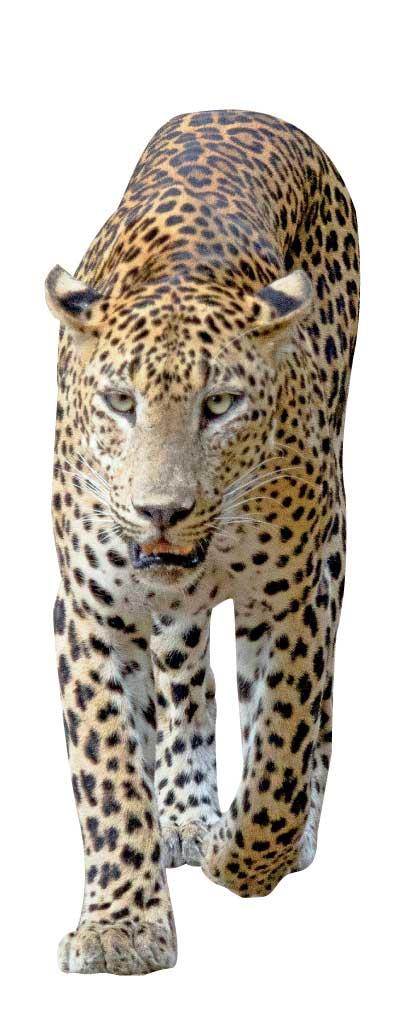
The bill was proposed in place of the Prevention of Cruelty to Animals Ordinance No. 13 of 1907. The bill was prepared in 2006 and tabled in Parliament in 2010 as a private member bill by Ven. Athuraliye Rathana Thera.
Subsequently, petitioners of the animal welfare writ application have consistently lobbied for its enactment since 2012. Due to objections from religious groups on humane killings among other delays, the passing of the bill is due.
“Important species such as leopards, elephants, tuskers and bears are killed using many cruel ways such as Hakka patas and snares when it comes to the case of leopards,” said Jayantha Wijesinghe, Convener of Rainforest Protectors Sri Lanka.
“According to the Flora and Fauna Protection Ordinance, laying snares is illegal. But we don’t see a mechanism to stop people from keeping snares. The same goes for Hakka patas. But the fines imposed on such crimes are minimal and negligible. Therefore, we could hardly control some of the things that have been happening,” he observed.
“But we have another option in the form of the Animal Welfare Bill which has been pending since 2006 and is not being enacted. There are provisions in it which address the use of snares and other cruelties towards animals. It is high time that we get the bill enacted. It may not be the strongest piece of legislation in its draft format, but when a separate authority on animal welfare is formed, there’s a greater chance of protecting these species, especially the protected and iconic ones. Apart from that, the pet trade too could be regulated,” he said.
“It’s sad to know that the black leopard died after being caught in a snare and this is not the first time it has happened to a leopard,” said Otara Gunawardena, founder of Embark Foundation and animal rights activist, who has consistently voiced out in bringing change to animals and the environment. “These kinds of incidents have to be addressed urgently as it’s affecting our wildlife,” she said.
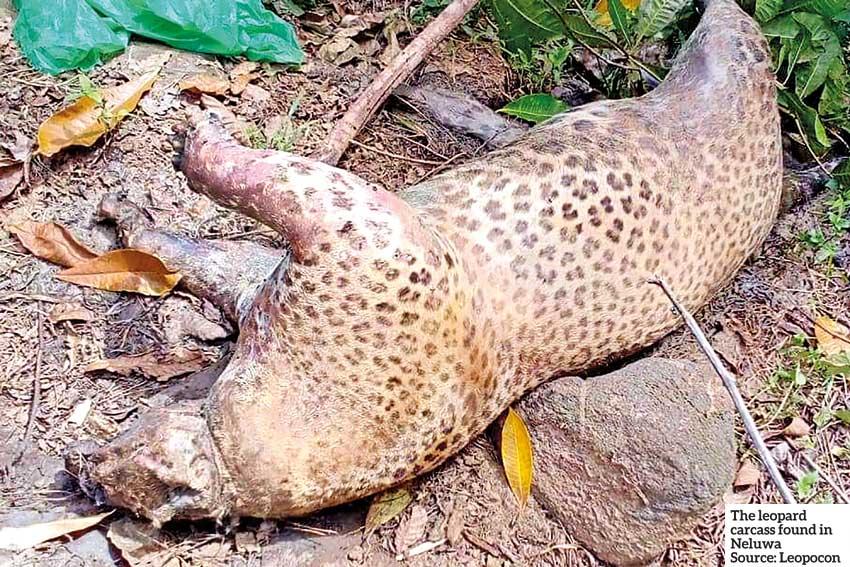
She said there were plenty of reasons as to why snares are laid. “Snares are often laid not for leopards but for other animals which pose a severe risk to the natural balance of the environment. Those animals are disappearing from forests and ultimately leopards are deprived of their food. This is a time to focus on bringing change to the animals in Sri Lanka by passing the Animal Welfare Bill. It has been pending for many years and gets overlooked all the time! It’s not just about the animals but our consciousness and our care as humans. If we don’t care for our animals and protect the environment it doesn’t reflect well on us as a society,” she said.
Kumar Dissa Saturday, 06 June 2020 12:48 PM
We should set snares for politicians instead.
mohomed Iqbal Saturday, 06 June 2020 10:08 PM
People living in the margins of forests are generally poor. For an extra income they grow vegetables in the unauthorized lands and also set traps for wild boar. Its only a few who set traps for animals. Their should be a new approach in getting people involved in decision making and a genuine approach to alleviate poverty. if the wild life department officials are not state officials they will also not bother. The situation in the plantation areas is pathetic. This comes from the British colonial times. The same state institutions are functioning with a head in Colombo. When you don't care the peoples lives why should you care only the wild life ?. If you visit most military personal, they too have leopard skins as trophies . We as Sri Lankans have to speak among ourselves and find common ground where all living beings can survive logically.
Kim Monday, 08 June 2020 12:02 PM
It saddens to see these rare majestic wild animals like the leopard dead. Unfortunately born on the wrong side of the planet where the people don't seem to care for animals of any kind.
Makanal Wednesday, 10 June 2020 10:53 AM
Seems none bothered about human life!
Charinda Dissanayake Friday, 12 June 2020 09:17 AM
Good article, but I'd like to point out a factual error in it. You state, and I quote, "The existence of the Sri Lankan Black Leopard which was believed to be extinct...". That is incorrect since these "black leopards" or correctly, melanistic leopards, are not a separate species, and as such cannot go extinct unless the entire population of Sri Lankan Leopards, Panthera pardus kotiya goes extinct. This melanism is produced due to a recessive allele, and exists in many cat species including leopards, jaguars, fishing cats, ocelots and so on. Being so does not make it a separate species, and so disappearance of all of these melanistic individuals from a population is not the same as extinction. You do not have to post this comment, this is just for your knowledge so you won't make the same mistake again.
WWW Monday, 15 June 2020 05:44 PM
Poachers hunted hundreds of tigers a year, pushing them to the brink of extinction. At the peak of the tiger trade this community alone may have hunted so many skins
Singh Monday, 15 June 2020 05:49 PM
They are small things but they make a huge difference. There is no excuse to poach anymore

Add comment
Comments will be edited (grammar, spelling and slang) and authorized at the discretion of Daily Mirror online. The website also has the right not to publish selected comments.
Reply To:
Name - Reply Comment
On March 26, a couple arriving from Thailand was arrested with 88 live animal
According to villagers from Naula-Moragolla out of 105 families 80 can afford
Is the situation in Sri Lanka so grim that locals harbour hope that they coul
A recent post on social media revealed that three purple-faced langurs near t